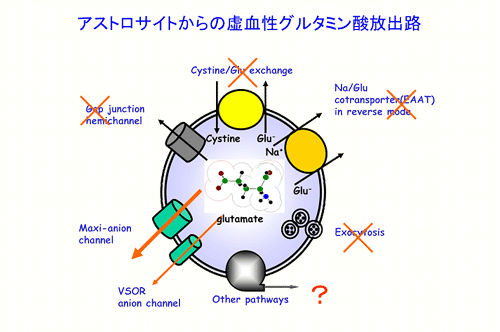Astrocytes occupy a key position between blood capillaries and neurons, provide a pathway for nutrients and metabolites traffic between blood and active neuronal network, and communicate with each other and with neurons. The short-range coupling of astrocytes is achieved via gap junctions, while the long-range communication is attained by releasing extracellular signaling molecules, such as excitatory amino acid glutamate and ATP, and these two often act synergistically. In the present report, we demonstrate, for the first time, that ischemic stimulation of astrocytes activates the glutamate-conducting maxi-anion channel, thereby serving as a major pathway for the release of glutamate.
In mouse astrocytes, both maxi-anion channel with a large single-channel conductance (of about 400 pS) and a volume-sensitive, outwardly rectifying (VSOR) anion channel with an intermediate single-channel conductance (of about several tens of pS) have been observed, and both of them can be activated by ischemic stress and cell swelling. The size of glutamate molecule (effective radius ~ 0.35 nm) is less than the pore size of either of these two anion channels, and they are both effectively permeable to glutamate (with Pglutamate/PCl of 0.2 and 0.15, respectively). In response to ischemic stress, astrocytes released glutamate, which could be effectively inhibited by maxi-anion channel blockers. VSOR channel blockers have less but yet significant effect on the release of glutamate. However, blockers of other reported glutamate releasing pathways, including Na-dependent glutamate transporters in a reversed mode, gap junction hemi-channels, and exocytosis had no significant effect on the glutamate release. And, because no ambient cystine was present in the present conditions, the involvement of cystine/glutamate exchanger could also be ruled out. The results obtained clearly demonstrated that the two anion channels jointly represent a major conductive pathway for the release of glutamate from swollen and ischemia-challenged astrocytes, with the contribution of maxi-anion channels being predominant.
Liu H, Tashmukhamedov BA, Inoue H, Okada Y, Sabirov RZ. Roles of two types of anion channels in glutamate release from mouse astrocytes under ischemic or osmotic stress. Glia 54, 343-357, 2006.

The maxi-anion channel as the major pathway of ischemia-induced glutamate release from astrocytes. There are minor contributions of VSOR anion channel and some unknown pathway. However, contributions of several pathways hitherto proposed can be ruled out.